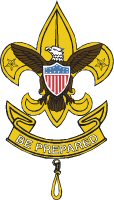Difference between revisions of "Scouts BSA"
Brucejohnson (Talk | contribs) |
Brucejohnson (Talk | contribs) |
||
| Line 1: | Line 1: | ||
{| cellpadding="30" cellspacing="0" | {| cellpadding="30" cellspacing="0" | ||
| − | | <div align="left">[[Image:First_Class_emblem_Boy_Scouts_of_America. | + | | <div align="left">[[Image:First_Class_emblem_Boy_Scouts_of_America.jpg|left|Boy Scouts BSA]]</div> || <div align="left">'''Boy Scouting''' is a membership level of the [[Boy Scouts of America]] (BSA) for boys and young men. It provides effective youth training in character, citizenship, and mental and personal fitness. Boy Scouts are expected to develop personal religious values, learn the principles of American heritage and government, and acquire skills to become successful adults. |
To achieve these, Boy Scouting applies eight methods of Scouting: Ideals (viz., the Scout Oath, the Scout Law, the Scout Motto, and the Scout Slogan), the patrol method, participation in outdoor programs, advancement, adult association, personal growth, leadership development, and the uniform. | To achieve these, Boy Scouting applies eight methods of Scouting: Ideals (viz., the Scout Oath, the Scout Law, the Scout Motto, and the Scout Slogan), the patrol method, participation in outdoor programs, advancement, adult association, personal growth, leadership development, and the uniform. | ||
Revision as of 14:57, 22 July 2009
| Boy Scouting is a membership level of the Boy Scouts of America (BSA) for boys and young men. It provides effective youth training in character, citizenship, and mental and personal fitness. Boy Scouts are expected to develop personal religious values, learn the principles of American heritage and government, and acquire skills to become successful adults.
|| To achieve these, Boy Scouting applies eight methods of Scouting: Ideals (viz., the Scout Oath, the Scout Law, the Scout Motto, and the Scout Slogan), the patrol method, participation in outdoor programs, advancement, adult association, personal growth, leadership development, and the uniform. Boy Scouting is generally available to boys between the ages of eleven and seventeen. They are organized in Scout troops, administered by volunteers with support of paid professional staff. Youth and adult members are Scouts, the boys are referred to as Boy Scouts, and the adults as Scouters. Contents |
Program and activities
The troop program and activities are determined by the senior patrol leader and the patrol leaders council under the oversight of the Scoutmaster. Troops generally hold meetings weekly, although they can be irregular during the summer. Troop meeting activities may vary from training in Scout skills to planning camping trips or playing games.
Troops may plan outings and activities outside the troop meeting. These may involve camping, backpacking, hiking, canoeing, rafting, climbing, caving, rappelling, and other activities. These outings are an important place for Scouts to work on skills and rank advancement, have fun, and engage in productive outdoor activities.
Most councils own and operate one or more permanent camps. These camps may host a variety of activities throughout the year. The summer camp program provides a week-long session for troops that includes merit badge advancement and adventure activities. Facilities may include ranges for shooting sports — archery, rifle, and shotgun — and for climbing and rappelling.
It is common for several troops within a district or council to gather at least once a year at a special weekend campout called a amporee. A camporee is a district- or council-wide event where several units camp and engage in activities, Scoutcraft competitions and learn specialized skills.
The national Scout jamboree usually occurs every four years, and draws more than 30,000 Scouts from across the country and the world. The last jamboree took place in 2005 at Fort A.P. Hill in Virginia, and the next will occur in 2010, celebrating the BSA's centennial.
Ideals
The Scout Law, Scout Oath, Scout Motto, Scout Slogan, and Outdoor Code are the cornerstones of Boy Scouting. Each Scout learns to use make these ideals a part of their way of life and personal growth. Boy Scouts must memorize and understand these ideals. They also represent these ideals symbolically in official emblems.
The Scout Sign is used when giving the Scout Law or the Scout Oath and as a signal for silence. The Scout Salute is used when saluting the flag of the United States. The left-handed handshake is used as a token of friendship and as an identity with Scouts worldwide.
